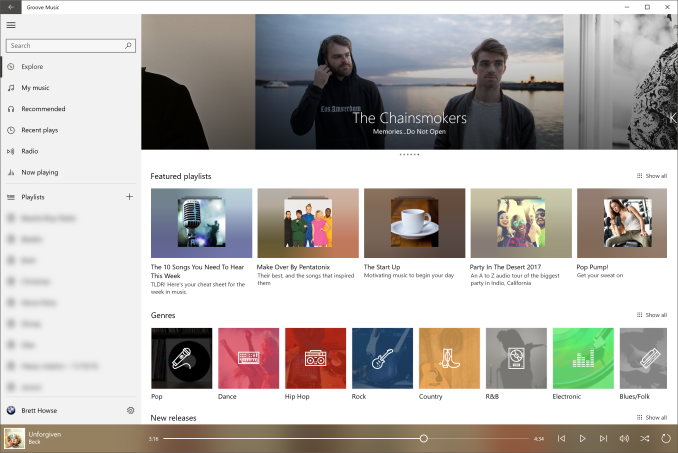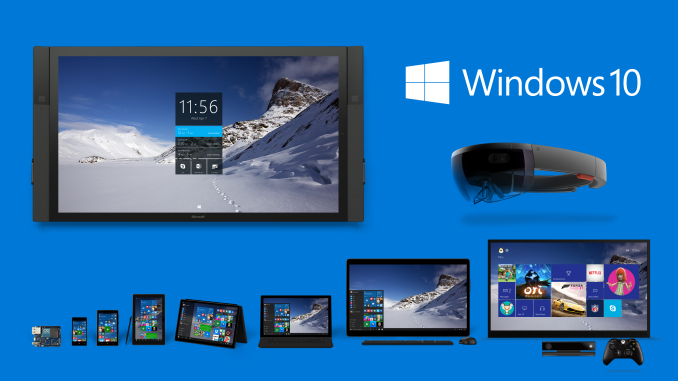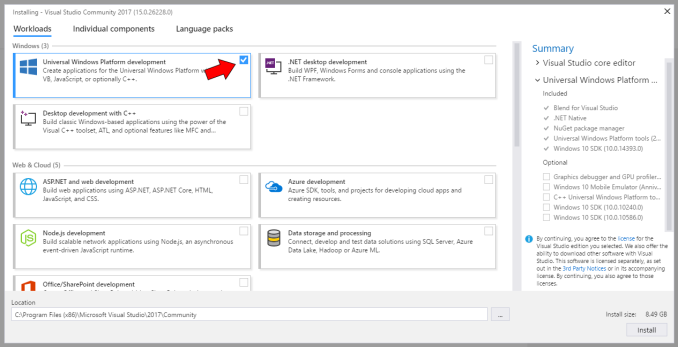The Windows 10 Creators Update Arrives
by Brett Howse on April 25, 2017 8:00 AM EST- Posted in
- Software
- Operating Systems
- Windows
- Microsoft
- Windows 10
Universal Windows Platform, now down a leg
For years, Microsoft was very clear about it’s ambitions to bring its platforms together, to give one single userbase to developers, rather than have to make apps for desktop, mobile, Xbox, Surface Hub, and eventually augmented reality. The efforts got serious in the Windows Phone 8 days, but it would still take several years for “Metro” apps to be morphed into the Universal Windows Platform (UWP). Microsoft promised a single platform for all of their apps, and they delivered. But it’s impossible to ignore their mobile play, which was floundering by the time they released Windows 10 Mobile.
Microsoft has all but abandoned their mobile efforts, instead embracing the dominant mobile ecosystems in Android and iOS, by bringing their apps to those environments. Sure, they still update Windows 10 Mobile, but with the Creators Update, only a handful of Windows 10 Mobile devices will be offered the update. It’s not a surprise, since Microsoft never really got any meaningful penetration in phones, but it certainly leaves UWP in an odd place. For years, Microsoft has been pushing UWP as a method to broaden application availability over multiple devices, but by abandoning their mobile strategy, it leaves them in a tough spot. UWP has suffered, perhaps partly because of this, but it certainly hasn’t gained the traction that Microsoft had hoped for. If it had, perhaps Windows 10 Mobile would not have been dead on arrival.
Without phone, UWP is now a tool to deploy apps across desktop, Xbox, Surface Hub, and mixed reality devices. But without a phone platform, that means that it’s basically just desktop. Even at just 5% phone usage share, phone would have been somewhere around 75-100 million devices. Xbox may eventually get there, but it’s going to be years, if ever. Surface Hub is a device that’s going to sell in the thousands, and Hololens is currently a developer-only item right now. That leaves the desktop, which is going to be the majority of the last official Windows 10 install base, pegged at 400 million devices at the end of September 2016. Expect a new figure to come soon, but regardless, almost all Windows 10 installs are on the PC.
That’s not necessarily a bad thing, although there are questions of where computing will go in the future, but for now, the PC is still the go-to device for most people when they need to get something done. But if one of your key points to pushing a new developer platform is cross-platform capabilities, but you only really have one platform that matters, it’s not ideal. Microsoft generally discusses upcoming developer news at their Build conference, which will be happening in May this year, so perhaps we will see some news there on where UWP goes from here.
The odd part about UWP and the cross-platform push that Microsoft has been doing for years, is that UWP could have been focused more on the desktop years ago, and improved to the point where it makes sense to use it on the desktop over older frameworks. But that push has never happened, despite some improvements to UWP.
Desktop has been held back by old app frameworks for years. Devices continue to improve, and older applications struggle to take advantage of High DPI displays, wide color gamuts, and more. UWP could have been the solution to this, but it was never sold as the solution to anything on the desktop. In fact, its limitations on the desktop are clear. Windows 10 brought the ability to run UWPs in a window on the desktop, but UWP is still treated as a mobile-first app platform, with all of the restrictions of a mobile device which is hampered by performance and power.
 Groove Music - a UWP Music app
Groove Music - a UWP Music app
Ideas that were spawned in the days of the push to mobile need to be abandoned, or at least add in options for developers to unlock more capabilities on the desktop. With 32 GB of memory in my desktop, I don’t really need apps frozen in the background when they aren’t the active window. With a desktop plugged into power, there is no reason a UWP can’t keep running all the time. Until desktop (and this includes laptops) becomes the focus of UWPs, the limited capabilities will restrict the apps that are brought to this framework, which means any benefits they would bring, such as touch support, share contract support, and high DPI capabilities, are going to be ignored for the more capable older frameworks.
Microsoft has done a lot of work to bring older applications to their store model, and that has been somewhat successful, especially with the Centennial bridge which allows Win32 apps to be converted to store packages, but at the end of the day, UWP needs to be a focus if they want it to succeed.












69 Comments
View All Comments
evilspoons - Tuesday, April 25, 2017 - link
Well, there was an extremely primitive registry in Windows for Workgroups 3.11 (not Windows 3.1), so it's more like 23-24 years :|lmcd - Tuesday, April 25, 2017 - link
While Windows 10 Mobile looks dead-ish, I wouldn't say for the reasons you guys have selected. The list of phones there consolidates the list of different cores Microsoft is supporting down to A7 (why this made the cut I don't know), A53, and Kryo. The former will probably be dropped soon, and Microsoft will go to exclusively ARMv8 powered devices. I wouldn't be surprised if support for ARMv8 devices lasts far longer than projected here. Microsoft is still investing hard in new ARM-based platforms, and devices within the same scope as those platforms will likely keep evolving.danjw - Tuesday, April 25, 2017 - link
Type: "Hopefully we will here some more news on this front soon." The "here" should be "hear".versesuvius - Tuesday, April 25, 2017 - link
In a nutshell Win 10 is one big mess. Just about everything Microsoft is doing is fixing a problem or iterating on a solution to an unknown problem. The cost and time that needs to be put into installing and running and keeping a watch on what is happening to the computer that is running Win 10 is too prohibitive.Mr Perfect - Tuesday, April 25, 2017 - link
The thing that bugs me in Creator's Update is the removal of the links to "Control Panel" and "Programs and Features" when you right click the start button. They've replaced them with links to the modern "Settings" and "Apps and Features", respectively. There are still to many settings that can't be adjusted in the modern apps, they're not ready to replace the legacy versions yet.On the other hand, they replaced "Command prompt" with "Power Shell" and Power Shell is absolutely ready to take over.
Samus - Tuesday, April 25, 2017 - link
What I find interesting are the browser power consumption benchmarks.I don't agree with Microsoft.
Edge is undoubtedly more power efficient on my laptop for light browsing sessions, but Netflix is more efficient in Chrome. Also, for light browsing, I'd say Chrome is the least efficient. It's like a Honda Civic, no matter how hard you beat on it, it gets the same fuel economy; Chrome consistently uses about the same amount of power. It is occasionally bested by Firefox and almost always bested by Edge, except in Netflix where Edge seems to use more power.
These are my observations over the years I've been running Windows 10, and honestly the anniversary update didn't improve the Netflix performance for Chrome. My laptop is a Haswell Elitebook 810 G2.
Allan_Hundeboll - Tuesday, April 25, 2017 - link
Like a Civic you say? I have Civic and it will do 15 km/l when I drive with a light foot. If I drive like I stole it it will only do about 10 km/l...Zeratul56 - Tuesday, April 25, 2017 - link
Why don't you use the Netflix app? It is pretty nice actually. I don't have my tablet in front of me but I am sure the memory footprint for the app is at least half compare to running in the browser.I am sure running Netflix in chrome has some hardware excelleration not found in other browsers. It would behoove Netflix to do that given the large user base of chrome.
I don't get why people don't jump on the app bandwagon in windows. I use the slack app over the browser as it uses much less resources. That seems to microsofts problem, they can't get people to break their old ways.
Shadowmaster625 - Tuesday, April 25, 2017 - link
I have yet to download, install, or otherwise use a single UWP app. Everything is still basically win32.mikato - Tuesday, April 25, 2017 - link
So there is no update or successor to Windows Movie Maker in this Creators Update?